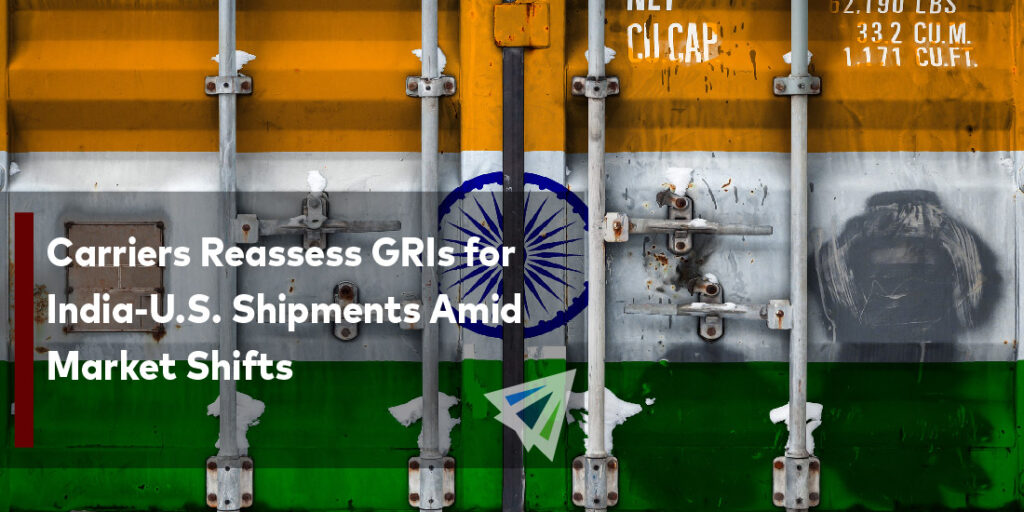
The following is an archived collection of our weekly insights throughout the month of September. Those who had signed up to our Interlog Insights newsletter received each week’s update to their inbox on the original release date. If you like what you see below, please feel free to sign up yourself to get these updates right as they come!
This month's insights
- U.S. Longshore Negotiations
- U.S. Import Forecast
- India Market Update
- Sustainability
Week 4 - Originally released Sep. 27
Insight: Employers Sue ILA Union Ahead of Strike Threat
A coastwide dockworker strike across the U.S. East and Gulf port system appears imminent as Oct. 1—the date which union leaders vowed to begin the labor action—is only three days away.
In the waning days, maritime employers have likely made their final push—a lawsuit against the International Longshoremen’s Association (ILA), the union representing 45,000 unionized dockworkers stationed at a dozen of ports as far north as Maine and as southwest as Texas.
On Thursday, the United States Maritime Alliance (USMX) announced it filed an unfair labor practice with the National Labor Relations Board, an independent U.S. agency designed to remedy grievances between employers and unions if one side chooses to have the federal board involved within the dispute.
“Due to the ILA’s repeated refusal to come to the table and bargain on a new Master Contract, USMX filed an Unfair Labor Practice (ULP) charge with the National Labor Relations Board (NLRB) and requested immediate injunctive relief – requiring the Union to resume bargaining – so that we can negotiate a deal,” USMX stated in the Thursday press release.
Forwarding the dispute to NLRB will not supply immediate friction to prevent unionized leaders from ordering their rank-and-file to picket in October so the litigation seems more symbolic than practical.
If USMX does pursue this legal path, a hearing before a NLRB judge would be scheduled at some point in the future where USMX and ILA would be obliged to make their arguments. However, a final verdict would likely take some time to arrive at, a window which could easily outlast the span of the looming port strike.
Interlog USA, through GEMCA, is the first and only logistics provider to guarantee proactive communication and cost awareness on the 5 milestones that impact your specific business the most.
Insight: Do Not Rule Out Government Intervention in Longshore Dispute
Barring a mutual agreement between ILA and USMX in the eleventh hour, the best bet at averting the potential strike is President Joe Biden’s executive privilege.
Spearheaded by a coalition of shippers and supply chain stakeholders through expressive letters, the White House has been perpetually reminded of its authority to thwart the labor action. The Taft-Harley Act empowers the president to intervene in labor disputes that threaten national security or safety.
The law would force ILA dockworkers back on the job while negotiations would resume between union and employers.
While it is true the executive office has the agency to evoke the Taft-Harley Act, the Biden administration has rejected the idea of using it in the current impasse, according to a quote from a White House official reported by Reuters and shared in last week’s edition of Interlog Insights.
That said, government intervention should not be ruled out.
Intent on being the most pro-union president in U.S. history, Biden of course will not commit to saying he would invoke Taft-Harley when a strike has not yet happened. Politically speaking, Biden may find it unwise to prematurely voice consideration of using the law since it could be perceived as an anti-union comment. After all, public optics are a bit more sensitive with the presidential election in November. While Biden himself is not running for reelection, the Democrat party is vying to retain the office and typically hinges on support from unionized labor.
However, if a strike occurs Oct. 1, the chance of the Biden administration interfering in the stoppage grows more likely. While solidarity with the longshore union would earn pro-labor marks, the economic ramifications of an East and Gulf coast strike and how this could sway undecided voters cannot be understated.
Not too many Americans question Biden’s pro-labor track record, but they certainly have criticized the state of the U.S. economy throughout his term. If Biden allows a dockworker strike to fester despite possessing the authority to act against it, voters may feel embittered that a supply chain crisis could have been avoided.
Week 3 - Originally released Sep. 20
Insight: White House Says It Won't Intervene in U.S. Longshore Dispute
On Tuesday, a coalition of U.S. shippers penned a letter formally compelling the White House to intervene in stalling negotiations for a new longshore contract that will cover 45,000 unionized dockworkers across U.S. East and Gulf coast ports.
The International Longshoremen’s Association (ILA) has vowed a coastwide strike if an agreement encompassing their demands is not met by Oct. 1, the day following the expiration of the existing master contract.
On the other end of the bargaining table is the United States Maritime Alliance (USMX), representing maritime employers, including ocean carriers and terminal operators. Released promptly after, USMX printed its support of the letter and stated it was “in strong agreement with the 177 trade associations who are calling for the immediate resumption of negotiations”. The shipper collation was diverse: the signees included prominent retailer groups, bulk industries, transportation associations, and logistics brokers.
Since June, ILA and USMX have not formally met for talks towards a new contract, a decision of the union’s accord.
Over the course of the summer and into the fall, the union has tightened its stance as if to prepare their rank-and-file to picket as soon as calendar flips to October. Earlier this month, ILA leaders held internal meetings where, according to them, details of coordinating a strike were discussed, a sober reminder now two weeks out that the hellish supply chain disruption could in fact materialize.
“A sleeping giant is ready to roar on Tuesday, Oct. 1, 2024, if a new Master Contract Agreement is not in place,” said ILA President Harold J. Daggett in a Tuesday press release.
ILA says it removed itself from the talks earlier this summer due to accusations of USMX engaging in an “ugly propaganda campaign designed to paint ILA longshore workers as ‘greedy’. The union is likely referencing the trickle of information that has been shared by maritime employers to the media throughout the past few months.
In one of the leaks, initially reported by the Wall Street Journal, a source close to the talks claimed ILA is seeking a 77 percent wage increase over the next six years (the lifespan of a master contract). For comparison, West Coast dockworkers achieved a 32 percent wage increase in their respective longshore contract ratified in July 2023.
The union went on to cite from a previous letter it wrote to members: “USMX claims to offer industry-leading wages, however their interpretation [of that] is polar opposite to ours.”
Neither ILA nor USMX have made the exact details of their proposals public, but in a letter to its members reshared in Tuesday’s press release, the union wrote: “USMX claims to offer industry-leading wages, however their interpretation [of that] is polar opposite to ours.”
Shipper coalition letter demands White House intervention
The shipper coalition’s letter attempts to draw an appeal to the Biden administration’s focus on supply chain resiliency, a focal point forced into view during the pandemic-era shipping crisis. They noted the actions the White House took then and used it as a springboard to address the present: use the powers of the executive branch to avert supply chain calamity.
The coalition referenced the administration’s intervening in other contentious labor negotiations: UPS and Teamsters; Class I railroads and several union chapters; and, as previously mentioned, last year’s West Coast impasse between unionized dockworkers and maritime employers.
They called on the Biden administration to “engage with the parties to quickly to negotiate a new deal or agree to continue negotiations while keeping the ports open and cargo flowing.”
Where do things stand at the moment?
On Tuesday, the same day the coalition dated the letter, an administration official informed that President Biden does not intend invoke a federal law to prevent a strike by ILA.
The Taft-Harley Act endows the executive office the authority to quell labor disputes that threaten national security or safety by imposing an 80-day cooling-off period—essentially, a back-to-order that would force dockworkers back on the job while talks would resume.
The administration official told Reuters, “We’ve never invoked Taft-Harley to break a strike and are not considering doing so now. We encourage all parties to remain at the bargaining table and negotiate in good faith.”
The part—“all parties to remain at the bargaining table”—has odd wording as if it implies the administration is not aware of ILA’s ongoing hiatus from the negotiations since June.
Whether a legitimate oversight or a trite public response, the wording nonetheless shines a light on how this labor saga has mainly flown under the radar of stakeholders, even those who are supply chain professionals. Maybe, after an eventful two or so more years of labor disputes across several industries, murmurs of union unrest have become standard lexicon, an ordinary constant in today’s world.
That said, an ILA strike is still hypothetical, not imminent. However, when Oct. 1 does come around, and if there is an actual coastwide work stoppage, the conversations will certainly change and, for those caught off guard, the tone will be panicked as the impacts of a port shutdown from Maine to Texas will heavily disrupt the U.S. economy and freight movement.
Insight: Carriers Announce Surcharges Ahead of Potential Strike
The potential for a strike to occur at the U.S. East and Gulf coast ports is looking more and more likely.
The current contract expires in less than two weeks (Sep. 30) and the ILA remains firm in its stance to strike if demands are not met. A couple of the key sticking points are wages and automation at ports.
From what InterlogUSA is hearing, some carriers have notified the Federal Maritime Commission and announced Work Disruption Surcharges (WDS).
Effective dates vary depending on the carrier. Also, keep in mind that these surcharges could be cancelled (pulled and released) if a work stoppage does not take place.
Consider your options, look at your contingency plans, and make sure you’re booking with the right carrier.
Do you have concerns about any of these considerations? Contact us [email protected] and an InterlogUSA team member will follow up with you.
Check out our other content!
Pay a visit to our website for a closer look at other InterlogUSA content, including recordings of past webinars, podcasts, and blogs. Also, follow InterlogUSA LinkedIn and Facebook pages for even more updates and content!
Week 2 - Originally released Sep. 13
Insight: West Coast Union Stands in Solidarity with ILA as Strike Date Approaches
As the labor dispute between the East and Gulf longshore union and maritime employers creeps towards a critical deadline, an influential voice has entered the conversation, one which pledges its support for the side of organized labor.
The International Longshoremen’s Association (ILA), which represents 45,000 dockworkers at U.S. ports along the East and Gulf coasts, has received backing from its unaffiliated counterpart stationed on the West Coast.
International Longshore and Warehouse Union (ILWU) President Willie Adams wrote in a statement Aug. 16: “The ILWU stands in solidarity with the ILA for a fair contract that respects dockworkers and protects our jurisdiction.”
While this first part evokes a milquetoast show of support, expected for a press release on such a contentious issue, Adams’ statement soon transforms into a declaration, a call to arms, and a decisive pact with the country’s two largest maritime transportation unions.
“From coast to coast, the ILWU and the ILA remain militant and resolute in our fight against automation. We will not settle for a substandard deal that does not adequately address our concerns about the future of our workplace and the safety of our members.”
Three main issues bridge the growing chasm between unionized leaders and maritime employers from reaching a new six-year coastwide contract: automation, benefits, and wages.
Perhaps the most irritating of these splinters is automation, which ILWU’s president namedropped in the statement above. Since June, ILA suspended negotiations with United States Maritime Alliance (USMX), representing ocean carriers and terminal operators, following a dispute with automative handling at a Gulf Coast port. That means it is likely throughout the entire summer that the two sides were not in contact with one another. At least, under the intentions of negotiating a new labor contract.
The lack of progress coupled with an overabundance of rhetoric has stirred anxieties among stakeholders. The existing master contract, covering ILA’s workforce, expires Sep. 30. Since last November, ILA President Harold J. Daggett has repeatedly vowed that the union will order its rank-and-file dockworkers to strike, a job action that would effectively shut down the country’s East and Gulf coast port networks, should a favorable deal not be offered by the end of September.
While not privy to sharing the details, USMX claims it has offered several proposals to ILA that are fair in the employers’ eyes. However, the union has not thought so. Earlier this month, ILA announced that it held internal meetings. Among supposed topics of discussion was the finalization of strike plans.
What does the West Coast show of solidarity mean?
Barring government intervention, ILA has the means to deploy disruptive tactics, like a strike, as it seeks its demands. That said, what about ILWU? When it speaks of solidarity, does the West Coast union also intend on striking?
Considering the ILWU president’s statement, which included the word militant, there’s reason to speculate that the counterpart would choose to strike alongside its longshore brethren. Which, if that were to happen, the nationwide disruption would be the trade-equivalent to a nuclear winter, an abrupt pull to a dark age for U.S. supply chains. However, such a stoppage is highly unlikely.
If anything, it’s more of a nightmarish thought experiment. It’s unlikely that ILWU dockworkers, who are spread across the coast from Seattle to Los Angeles, are allowed such liberty upon ratifying their respective six-year contract last summer.
While perhaps there’s a magical loophole, a labor contract is a binding legal document which no doubt would have to include stipulations regarding strikes or other job actions. Even if ILWU attempted a work stoppage, West Coast employers would promptly sue to enforce an injunction (back-to-work order). The maneuver that would likely take them little time and effort to perform.
Strike or not, develop a contingency plan with your transportation partners
Less than a month away from this potential disruption, East and Gulf coast ports remain operating fine. However, as the deadline nears, and a deal still not reached, supply chain professionals should consider contingency plans, especially on bookings set to sail post-September.
Even though ILWU stands in solidarity with ILA, the chances are minimal that their support translates towards actual disruptive actions. The West Coast stands as the immediate best option for routing diversions. Canadian or Mexican ports as well could be an intriguing alternative, especially if an already crowded West Coast is overwhelmed with additional freight volumes in the event of a strike.
Shipper Hotline: Industry Question and Answer
Have a question about international shipping and logistics? Email our team at [email protected]
We’ll get back to you right away and may feature your question (anonymously) on our next edition of Interlog Insights!
Insight: Retail Group Upgrades September U.S. Import Forecast
According to the Global Port Tracker report released by the National Retail Federation and Hackett Associates, major U.S. container ports are anticipated to experience another busy month in September. NRF projects September volumes to total 2.31 million TEU (twenty-foot equivalent units), an increase of 14 percent year-over-year.
“This has caused some cargo owners to bring forward shipments, bumping up June-through-September imports,” Ben Hackett, Hacket Associates founder, said in a press release. He continued, “In addition, some importers are weighing the decision to bring forward some goods, particularly from China, that could be impacted by rising tariffs following the election.”
What do they predict U.S. import volume to be for the remaining months of the year?
NRF forecasts October volumes to total 2.08 million TEU, an increase of 1.3 percent year-over-year. For November, the performance is expected to be 1.92 million TEU, an increase of 1.6 percent. December is forecasted to come in at 1.89 million TEU, an increase of 0.9 percent.
Last month, NRF reported that inbound U.S. cargo volume could see a near-record increase in August. While final August numbers await to be released, NRF predicts that U.S. imports last month came in at 2.37 million TEUs which would be a 21 percent year-over-year increase.
Week 1 - Originally released Sep. 6
Insight: World's Largest Sail-Powered Ship Crosses Atlantic Ocean
|
The world’s largest sailing cargo ship completed its maiden voyage across the Atlantic Ocean. Coincidentally, the ship was laden with cognac and champagne—appropriate items for a celebratory toast considering the feat the intrepid vessel accomplished. On Aug. 13, the French-flagged Anemos left France’s Port of Le Havre and arrived at the Port of New York and New Jersey early morning on Sep. 3. The vessel’s nearly month-long journey was propelled by one of the world’s cleanest forms of energy—wind. Relevant Content: “Three Designs That Could Decarbonize International Shipping” “For centuries, we knew wind was abundant [over] the deep sea,” Transport A La Voile (TOWT) CEO Guillaume Le Grand said in a statement. “But now, thanks to satellite communication and routing technology, wind is also predictable, which makes it reliable.” The French-based TOWT commissioned the 266-foot-long ship. Over the last couple of years, the company has shared concepts of sail-powered cargo ships and believes the technology can be a competitive alternative to gas-guzzling containerships. However, the transatlantic hop of Anemos proves their vision extends beyond drawing boards and blueprints. The ship’s successful trip between two continents is a real-world example of container shipping’s accelerated push to decarbonize. About the Anemos The shipments aboard the Anemos reportedly have a carbon footprint one-tenth that of a standard, gas-fueled containership. And, in what gas-fueled cargo ships otherwise would call a reciprocating diesel engine, the propelling force behind Anemos is a system of cloth sails. The equipment is deployed and handled automatically via computer programming. As one would already guess, the operation is considerably cleaner than traditional ocean freight transportation. According to calculations from TOWT, over its transatlantic course, Anemos averaged less than two grams of carbon emissions per one ton of cargo transported over a kilometer. In comparison, gas-powered cargo ships—the industry standard—emit at least 20 grams per ton over the same distance. A precaution in case of emergency, Anemos does have two diesel-electric engines installed. TOWT says the ship is part of a planned fleet of eight ships. Is the future sail? Ocean freight transportation is certainly trending towards greener practices, but the immediate viability of zero or reduced carbon alternatives has yet to be seen. International trade continues to grow as shipment volumes across global lanes flourish. Stakeholders are always jockeying for the fastest transit times, the lowest shipping rates, and the most space aboard a vessel. This leaves the bar high for greener innovations to take hold. At this time, there isn’t an alternative developed at the scale to compete with the gas-guzzling status quo. Anemos is the world’s largest sailing cargo ship and was able to deliver 1,000 tons of cargo. It’s an impressive accomplishment given the context, but that’s hardly a serviceable capacity when compared across the board. On average, a conventional (gas) ship can carry 38,000 tons of cargo, dwarfing the sail-powered ship’s offering. Another hurdle innovations face is transit time. In the case of Anemos, the voyage took three weeks to sail from Le Havre to New York. For gas ships, the same journey typically takes 15 days. While TOWT is optimistic it can reduce transits to the industry standard, the present-day performance is noticeably slower. This isn’t to say that sail technology has no future in ocean freight transportation. Like electric or nuclear, wind is a sustainable source of power that, in the long-term, would reduce operating costs and lower emissions for ocean carriers. If the future had to be predicted, it’s likely that sail, as with electric and nuclear, will be gradually initiated into the gas-dependent shipping industry. Hybrid operating systems will be developed. The likes of which could be an awe-inspiring concept of a ultra-large container ship donning a sail as massive as a high-rise apartment building. |
Insight: Ports in India Hit Hard by Severe Storms
Severe monsoon floods have severely impacted container traffic and transport networks across the ports in the Indian subcontinent, including Bangladesh, the Journal of Commerce reports.
Mundra Port, India’s largest container port, is currently muddled after being forced to suspend operations for several days last week due to the intense weather. This has intensified ongoing issues with sailing reliability, particularly those related to extended transit times around southern Africa.
Carriers serving Mundra have told customers to expect delays in their export and import shipments because of these weather disruptions.
India port strike averted
In other news out of India, a mass strike taking place across several of the country’s seaports has been avoided. A tentative agreement for a five-year labor contract has been reached between maritime employers and union representation. The contract is set to cover some 20,000 unionized longshore workers employeed across key ports.
As Supply Chain Brain reports, the union rank-and-file accepted an 8.5 percent pay bump back-dated to January of 2022. The members were working without a contract since the end of 2021.
Check out other India-related market material!



